By Kozma Ahačič (Research Center of the Slovenian Academy of Sciences and Arts) and Sonja Svoljšak (National and University Library, Ljubljana)
In December 2021, a comprehensive study with the title Stati inu obstati was published. It provides detailed analyses of the first fifty printed books in Slovenian.
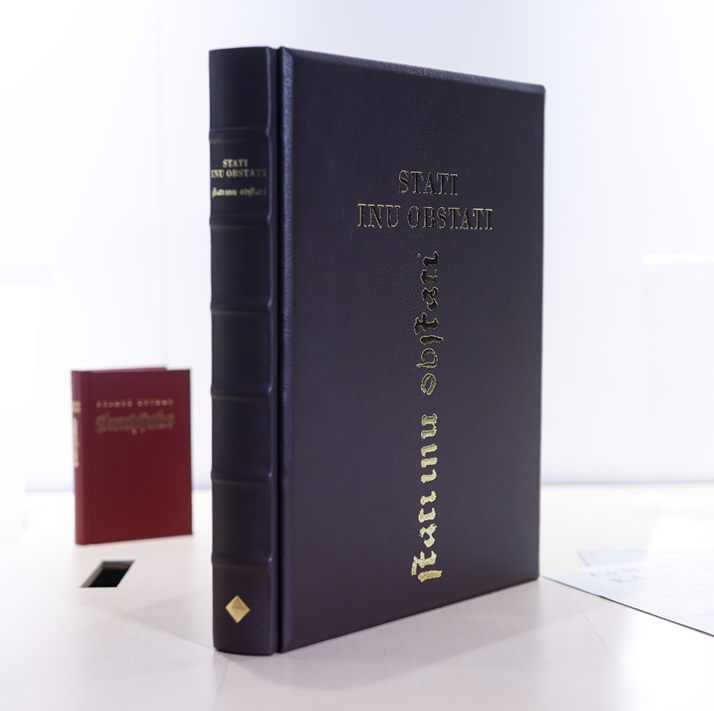
The featured books were published between 1550 and 1603. These dates delimit the period marked by sixteenth-century Slovenian Protestant authors. The books were written by nineteen authors. Most of them were editors or contributed only poems and forewords, whereas nine were authors of original texts or translations. The term book is used very loosely because the study includes such works as a single-page leaflet that was actually a trial impression. The number fifty is also symbolic. For example, the work Ta prvi dejl tiga Noviga testamenta (1557–1558) is treated as a single book although its individual components—Ta slovenski koledar (1557), Eno dolgo predguvor (1557), and En regišter, eno kratko postilo (1558)—can also be regarded as separate works. Different bibliographic descriptions deal with the works in question in various ways as well.
Each book is presented with photographs and a description, which consists of the following standard sections: the full title of the book and its translation or transliteration into modern Slovenian if necessary, the abbreviated title, the year and place of publication, the circumstances of the book’s origin, a concise description of the contents, additional interesting facts (including the most important information about each book’s research history), a list of preserved copies, and an evaluation of the overall importance and impact of the work.
In order to update information about the preserved copies of these sixteenth- and seventeenth-century editions that are now kept in many different public or private collections around the world, catalogues, databases, and other resources have been thoroughly investigated during the past few years. The catalogues of libraries and other institutions provided invaluable information about the copies already known as well as about those that were not recorded in previous studies and bibliographies of the earliest printed Slovenian works.
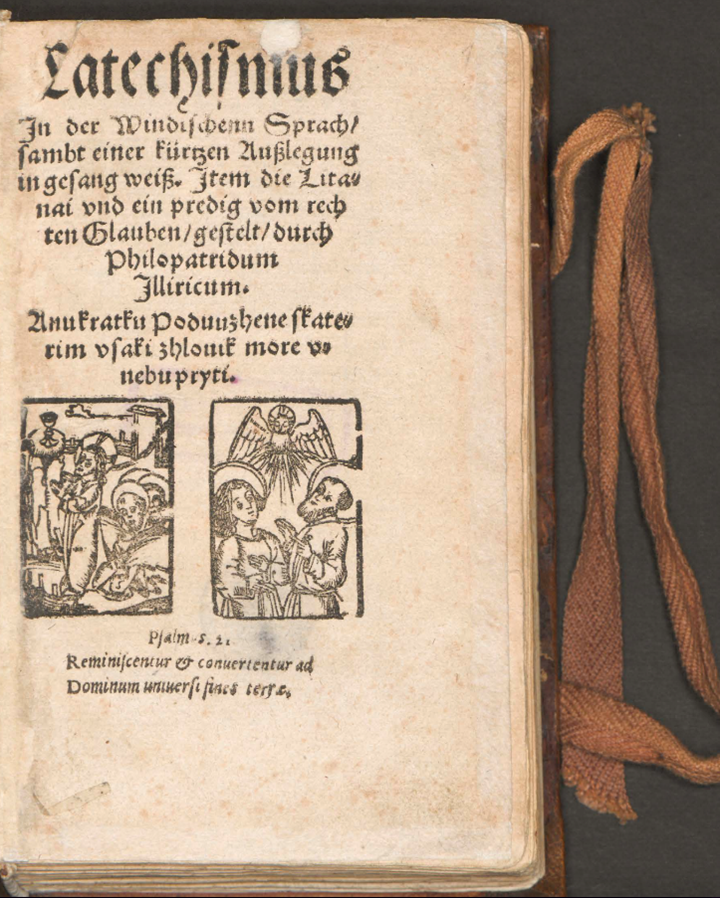

The first two printed books in Slovenian: Catechismus and Abecedarium, 1550
(©Austrian National Library, shelf number 18.Z.44)
In most cases, bibliographic information in public resources sufficed to identify individual works and editions of interest. However, the only constant in cataloguing standards and practices is that they are constantly changing. Transcription as well as the comprehensiveness and accuracy of information given in bibliographic descriptions can vary greatly from one era to another, from one institution to another, and from one country to another. The human factor is crucial as well. Misspellings, typos, and similar slips can sometimes make it almost impossible to successfully identify works, editions, or copies of interest. Incomplete copies with missing title pages or other sections of the text that would allow the cataloguers to record the most crucial information are also a common problem. Due to the political circumstances of the period, many editions did not contain any authorship statements, which presents an even greater challenge. The older and the rarer the edition, the more potential puzzles and problems for the cataloguer and for the researcher. These books certainly fall into both categories.
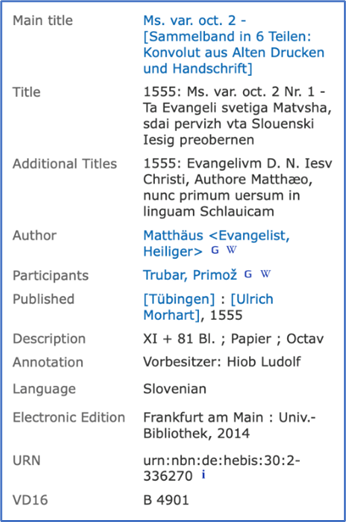
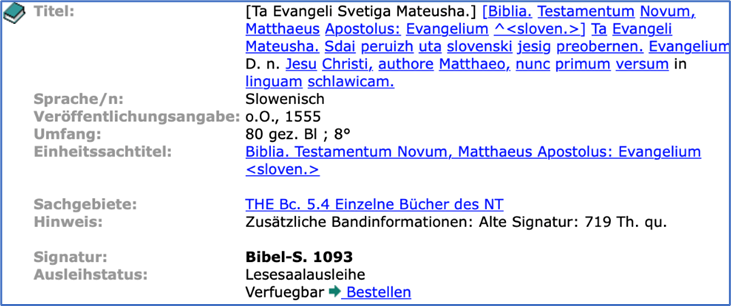
The last comprehensive study and inventory of the earliest books in Slovenian was carried out by Branko Berčič in 1968. Bibliographic descriptions in VD16, which is usually the first resource of choice for researchers, are based on his data. During the preparation of Stati inu obstati, the Karlsruhe Virtual Catalog was also used as a starting point to search for the copies that were previously unknown to the research community. It turned out that new finds were possible even in cases in which works were not recorded correctly if atypical queries were used. Some works could be retrieved by using parts of titles that simply cannot be transcribed in the wrong way, or title versions from intermediary title pages that could have been recognized as main title pages. Querying with predictable spelling mistakes that could have been made during transcription of sixteenth-century Slovenian also proved useful, and so did querying the catalogues of smaller libraries in places where Slovenian Protestant authors were known to have resided. Such queries are of course time consuming because of the numerous results they return, but the approach nonetheless proved to be useful for discovering these old works. Thus, one more copy of individual editions from 1562, 1563, 1566, and 1576, two more copies of editions from 1555, 1567, and 1575, and three more copies of editions from 1557 and 1592 were found. Three more copies were already located in the City Archives of Memmingen in 2013.
A frequent problem with such queries is also an unclear distinction between catalogue records for different kinds of reproductions (i.e., microfilms and photocopies) and for the originals. Therefore, the authenticity of individual copies often has to be additionally checked with the library. The librarians are usually of great help and very responsive. The possibility of a quick snapshot they are now able to make with a mobile phone also helps greatly when such authentication is necessary.
In the case of Jurij Dalmatin’s Jesus Sirah from 1575, which is kept at the Darmstadt University and State Library, it turned out that it contains manuscript “corrections” in a later form of Slovenian. Without the librarian’s help, we certainly would not have been able to obtain this very interesting piece of information.

(shelf number V794, photo by Bastien Rissoan)
However, when one is in doubt, there are also other options. One of them is to reach out for help from the international research community. This is exactly how we decided to approach a particular problem with one of the editions. After careful consideration, we decided to turn to CERL’s mailing list and make an inquiry about the preserved original copies and later reproductions of Hieronymus Megiser’s 1603 edition of Thesaurus Poliglottus. We were almost instantly overwhelmed with answers from all over Europe. These were later followed by responses from around the world. With the help of the CERL community, we were thus able to identify and locate eleven previously unknown copies at ten European institutions.

shelf number 1853, photo by Tomo Jeseničnik)
We certainly consider this to be the right place and the right opportunity to express a sincere acknowledgment to everyone that contributed to our findings back in September 2021. However, as in all research, the curiosity and the quest for information does not simply end at a certain point in time. Although the list of the preserved copies of the earliest books in Slovenian[1] is now much more complete, many questions remain open—and so do our hopes of finding new editions and copies, particularly those that are now considered lost.
One such work is Elementale Labacense and Nomenclatura trium linguarum, Latinae, Germanicae et Sclavonicae by Adam Bohorič. This very thin booklet in small octavo was published in the 1570s and was last seen around 1900 in Fischer’s antiquarian shop in Ljubljana. He sold it for 100 florins to a Dutch antiquarian bookseller, who specialized in almanacs. The booklet, which consists of two parts, was used as a textbook and as the primary reference dictionary for Latin, German, and Slovenian in the Ljubljana Protestant Estates School. The discovery of this work would be of crucial importance. It would explain the development of orthography in the most important work in Slovenian of the period: Jurij Dalmatin’s Bible from 1584. It would also provide significant information about the role of Slovenian in the first grades of the Estates School.
The other work is Formula concordiae by Primož Trubar from 1581. The exact title on the title page is not known, but the Latin expression formula concordiae almost certainly appears in the German text, which would be next to the Slovenian title page. The book was published by Georg Gruppenbach in Tübingen in 1581, probably in octavo. Not much else is known about it.
The most important and the most sensational would be the discovery of a work that is mentioned by Primož Trubar in one of his texts from 1575. According to Trubar, the title of the work in question was Compendium catechismi catholici in Slavonica lingua. It was prepared by Lenart Pachernecker (or Leohnard Pachenecker) in 1574 and was published in Graz. It is not clear if this is the actual title, nor is Pachernecker’s name necessarily stated anywhere in the work because he may have only prepared the translation template. This find would be of epochal significance for understanding the relations between the Protestants and the Catholics, and for understanding the Catholic side’s role in the establishment of standard Slovenian.
In the spirit of never-ending curiosity and the quest for information that could shed even more light on this very important period in Slovenian history, language, culture, and typography, we would therefore like to turn to the CERL community once again. Any information about these three works would be invaluable and sincerely appreciated, especially because any new finds of the earliest books in Slovenian are usually at the very center of research and media attention here.
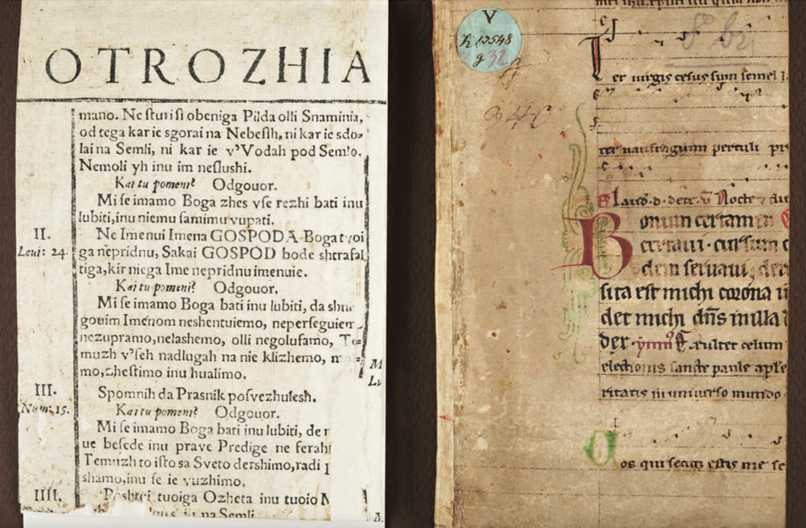
[1] The list will be published in two parts in 2022.


Right: National and University Library, Ljubljana
